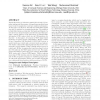Free Online Productivity Tools
i2Speak
i2Symbol
i2OCR
iTex2Img
iWeb2Print
iWeb2Shot
i2Type
iPdf2Split
iPdf2Merge
i2Bopomofo
i2Arabic
i2Style
i2Image
i2PDF
iLatex2Rtf
Sci2ools
MOBICOM
2015
ACM
2015
ACM
Keystroke Recognition Using WiFi Signals
Keystroke privacy is critical for ensuring the security of computer systems and the privacy of human users as what being typed could be passwords or privacy sensitive information. In this paper, we show for the first time that WiFi signals can also be exploited to recognize keystrokes. The intuition is that while typing a certain key, the hands and fingers of a user move in a unique formation and direction and thus generate a unique pattern in the time-series of Channel State Information (CSI) values, which we call CSI-waveform for that key. In this paper, we propose a WiFi signal based keystroke recognition system called WiKey. WiKey consists of two Commercial Off-The-Shelf (COTS) WiFi devices, a sender (such as a router) and a receiver (such as a laptop). The sender continuously emits signals and the receiver continuously receives signals. When a human subject types on a keyboard, WiKey recognizes the typed keys based on how the CSI values at the WiFi signal receiver end. We impl...
| Added | 14 Apr 2016 |
| Updated | 14 Apr 2016 |
| Type | Journal |
| Year | 2015 |
| Where | MOBICOM |
| Authors | Kamran Ali, Alex X. Liu, Wei Wang, Muhammad Shahzad |
Comments (0)

